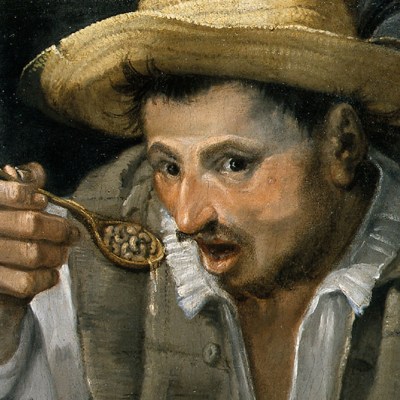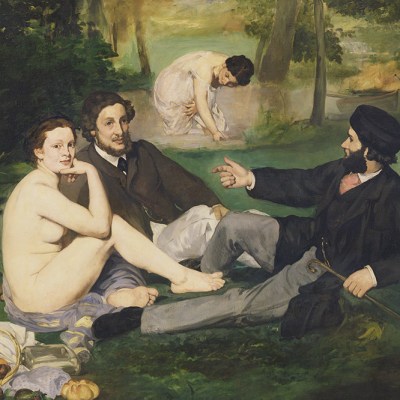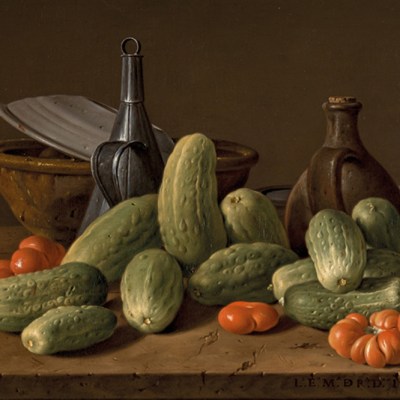From the July/August 2025 issue of Apollo. Preview and subscribe here.
It is a charming image of plenty and anticipation, depicting that happy moment when the work of cooking is complete and the food is ready to enjoy. Two smiling, buxom young women present the fruit of their labours at the hearth to two men seated at a table. One woman tips a copper pot of hot, freshly made yellow polenta on to a white cloth spread on the table. Standing behind, her companion holds the batone, the long, wooden stick used to patiently stir the ground maize as it cooks and softens in water.
The painting, from 1740, is by the Venetian artist Pietro Longhi, who was known for his chronicling of scenes of contemporary life. Bernard Berenson wrote that Longhi ‘painted for the picture-loving Venetians their own lives in all their ordinary domestic and fashionable phases’. Such was the fondness for polenta in Venice that the comedy La donna di garbo (1743) by the Venetian playwright Carlo Goldoni contains an account of the cooking of polenta by Rosaura, its young female protagonist, in which she calls polenta ‘as beautiful as gold’.
The word ‘polenta’ was originally used to describe any grain or pulse cooked until very soft, but in the Italian kitchen it came to mean specifically maize. The crop’s introduction into Europe is an example of what is called the Columbian Exchange, the movement of plants, animals and diseases between the New World and the Old World that followed Christopher Columbus’s first voyage to the Americas in 1492. The tomato – now regarded as a quintessentially Italian ingredient – is another instance, coming originally from South America.
Maize (Zea mays), also known as corn, is one of the world’s great staples. Together with wheat and rice, maize provides around 50 per cent of the calories that humans consume around the globe. It is generally thought that maize is descended from a wild grass called teosinte and that Mexico was the place where it was first domesticated, between 7,000 and 9,000 years ago. Maize played a central part in ancient Meso-American civilisations, including the Maya and the Aztec. It was an essential crop for food and chicha, the maize beer used for libations. In the Popul Vuh, the sacred text of the Maya K’iche’ people of Guatemala, human beings are created from maize. In Maya civilisation the maize god was an important deity. He was often depicted as a handsome young man, with his headdress and hair resembling a stylised ear of corn. In the agricultural cycle of life, he embodied vitality and new growth.
The Polenta (c. 1740), Pietro Longhi. Ca’ Rezzonico – Museo del Settecento Veneziano, Venice. Photo: Matteo De Fine; © Photo Archive – Fondazione Musei Civici di Venezia

Pre-colonial Meso-American and Andean societies developed a way of treating maize to make it more digestible. The process – called nixtamalisation, from the Nahuatl word nextli, meaning ‘ashes’ – involves soaking and cooking dried maize in an alkaline solution, made by mixing water with ashes, lime or shells. This made the fibrous skins on the kernels easy to remove; importantly, it also made maize more digestible and increased its nutritional value. While maize was introduced to Europe and cultivated with enthusiasm as a food crop, the process of nixtamalisation was not adopted. As a result, during the 18th and 19th centuries, the rural poor in Europe who lived on a diet consisting largely of maize suffered from pellagra, a disease caused by a deficiency of vitamin B3 (niacin) – the nixtamalisation of corn makes the niacin within the grain available to the human body.
The Veneto was the first region of Italy in which maize was cultivated. The region’s port city, Venice, had a thriving mercantile economy which saw traders introducing novelties to a receptive audience. Maize was first sold in Venice at the Rialto Market in 1495. It was thought to come from Turkey, and so was called granoturco, ‘Turkish grain’. An early Italian depiction of maize is found on a frescoed ceiling in Palazzo Grimani in Venice, painted in 1563 by Camillo Mantovano. Italian cooking is rich in regional variety, and to this day polenta is especially associated with the Veneto. What was once the mainstay of agricultural labourers now appears on restaurant menus. The Venetians prize a delicate-flavoured white polenta, paler than that depicted by Longhi. In Venice, this white polenta, cooked in ample water to be very soft, is often served topped with seppie al nero (cuttlefish braised in its own black ink) – a visually striking dish and one worth seeking out
From the July/August 2025 issue of Apollo. Preview and subscribe here.


